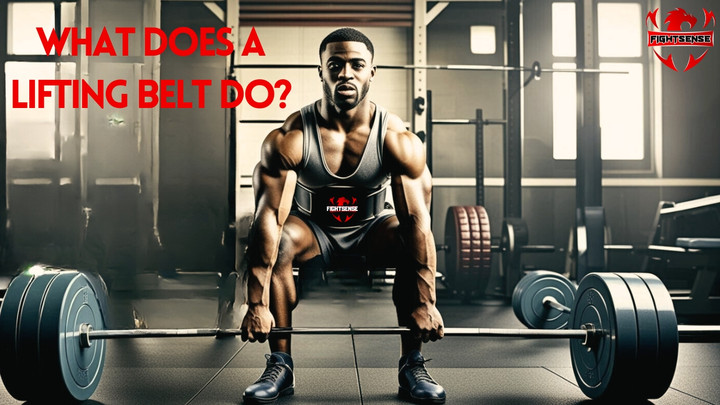What Does a Lifting Belt Do? Advantages& Usage Explained
17th Mar 2025
Among the most hotly contested items in the fitness industry is a lifting belt. While some lifters swear by it, others find it superfluous. But just what precisely does a lifting belt accomplish? Knowing how a weightlifting belt works will enable you, regardless of your level of experience, to make a wise choice. This tutorial will break down the benefits, ensure proper usage, and highlight the key considerations when using a lifting belt.
Key Highlights
-
A lifting belt enhances core engagement and stability.
-
It fixes posture and lessens lower back discomfort.
-
Use it not for every exercise, but for big compound motions.
-
Only proper bracing can maximize its advantages.
-
A belt enhances rather than substitutes for core strength.
The mechanism of a lifting belt
A lifting belt is used to raise intra-abdominal pressure (IAP), therefore stabilizing the core muscles and spine. A lifting belt lets unrestricted mobility while strengthening core engagement and posture, unlike a support brace that limits movement.
Main purposes of a lifting belt:
-
Core Stability Enhancement
-
Spinal Alignment Support
-
Intra-Abdominal Pressure Generation
-
Bracing & Power Production
-
Injury & Hyperextension Prevention
For lifting, what does a belt accomplish?
Strength training depends much on a lifting belt since it generates pressure around the core, thereby supporting the lower back and preserving stability. During large lifts, this extra pressure improves posture and guarantees lifters ' correct technique, therefore lowering their chance of injury.
The belt reduces strain during actions including squats, deadlifts, and overhead presses by supporting the spine under significant weights. A weightlifting belt also improves core engagement, therefore enhancing the safety and efficiency of lifts.
Preventing hyperextension of the lower back is crucial for maintaining a neutral spine posture and avoiding unnecessary injuries.
Who uses a gym belt?
Extra stability during complex motions comes from a gym belt, which helps lifters keep control when working out involving several muscle groups. It lessens too much bending and incorrect form, which, if not rectified, may cause injury.
Wearing a gym belt also promotes improved breathing habits, especially for bracing—which is absolutely vital for preserving intra-abdominal pressure. When carrying more weight, this pressure not only improves stability but also confidence.
Furthermore, by supporting spinal alignment and enabling lifters to perform at their best and so reduce the danger of lower back strain, a gym belt is essential for injury prevention.
Advantages of a Lifting Belt
1. Enhanced Core Stability & Support
Core stability is absolutely vital while lifting large weights. An external support system that keeps your waist taut helps you to lift with more confidence and control—a lifting belt.
2. Lessened Lower Back Strain
A weightlifting belt helps to equally transfer pressure across the lower back, therefore lowering too much tension and avoiding damage. Those who have a history of back discomfort or those engaged in high-intensity lifting programs will find this feature very helpful.
3. Enhanced Lifting Capability
A lifting belt generates intra-abdominal pressure, therefore facilitating more effective lifting. When used properly, many lifters find their strength output increases between 5 and 15 percent.
4. Promotes correct form and posture
A belt offers a tangible cue to keep your back straight and chest raised during lifts. This tip helps avoid typical mistakes, such as being too forward-leaning, which could cause accidents.
5. Improved Bracing Method & Breathing
When lifting big weights, proper breathing is really vital. A belt helps the Valsalva maneuver—a method in which you inhale deeply and brace your core before lifting to provide further spinal stability.
When should one use a lifting belt?
Though not necessary for every activity, lifting belts provide advantages. You should give using one some thought here:
-
Perform heavy compound exercises such as deadlifts, squats, and overhead presses.
-
You should be weightlifting at 80% or more of your one-rep maximum.
-
If you want further assistance and have lower back issues, please contact us.
-
In strength sports, include CrossFit, weightlifting, or powerlifting.
When Not to Wear a Lifting Belt:
-
The condition occurs during bouts of light to moderate lifting.
-
The resulting physique is ideal for isolated workouts, such as leg extensions or bicep curls.
-
If you haven't yet developed appropriate core strength,
-
The goal is to offset current injuries or bad form.
Correct Use of a Lifting Belt
1. Should choose the appropriate belt.
-
Perfect for powerlifting and optimum support are leather belts.
-
Nylon belts give dynamic movements flexibility.
-
Prong or lever belts should guarantee a tight, changeable fit.
2. Get the Belt Right
-
Cover the lower abdomen right above your hip bones.
-
Tighten it to be snug but not unduly constrictive; you should still be able to breathe.
3. Get proficient at the bracing technique.
-
Breathe deeply into your tummy, then begin to lift.
-
To build stability, press your abdomen up against the belt.
-
Hold the pressure while lifting, and, keeping your core engaged, exhale at the peak of the exercise.
Typical Mistakes to Prevent
-
Making Every Lift Using a Belt
-
Ignoring Core Instruction
-
Bad Belt Positioning
-
Neglecting Bracing Correctly
Thought Notes Final
A lifting belt thus serves what purpose? When used properly, it increases core engagement, boosts lifting performance, and helps to avoid lower back problems. It should not, however, be a crutch for inadequate form or weak core muscles. Should you lift heavy, a belt might be a great purchase—but only if you know how to use it correctly.
Disclaimer
This material serves only for informative needs. Before utilizing a weightlifting belt, always see a fitness professional particularly if you have pre-existing medical concerns.

